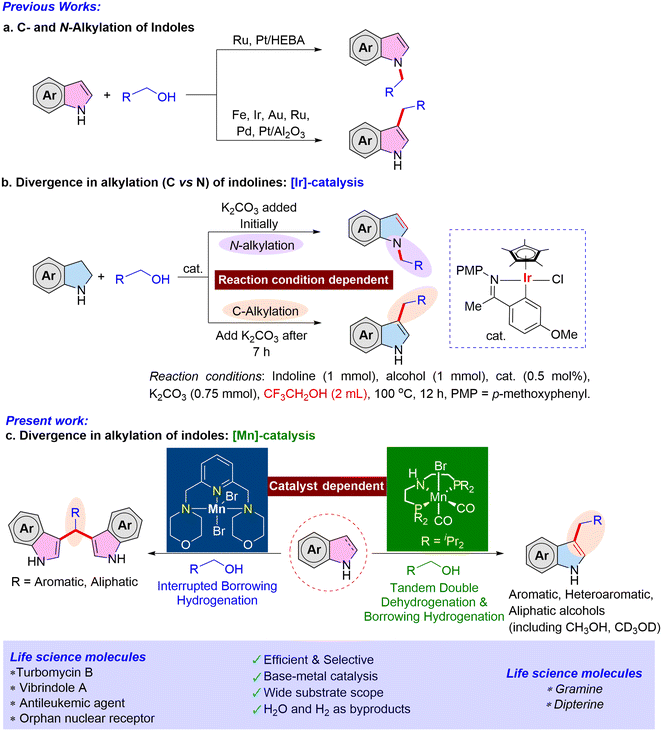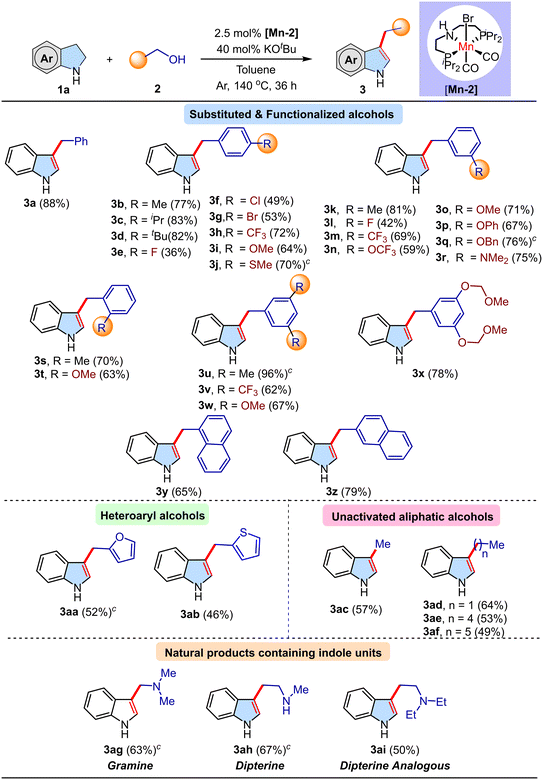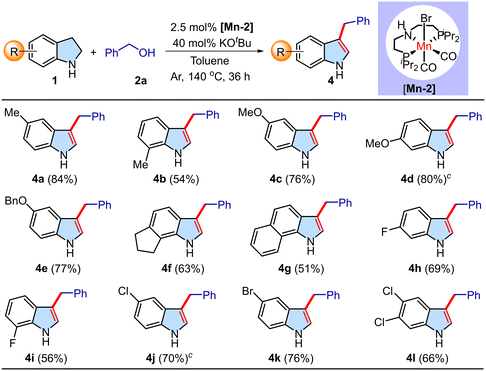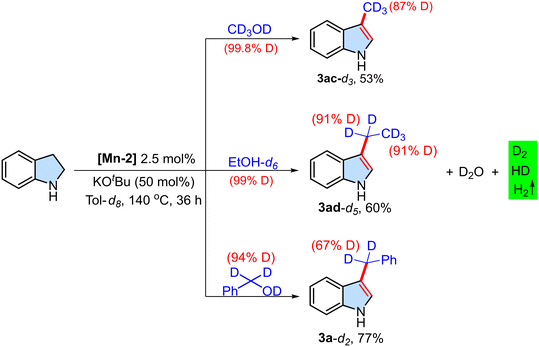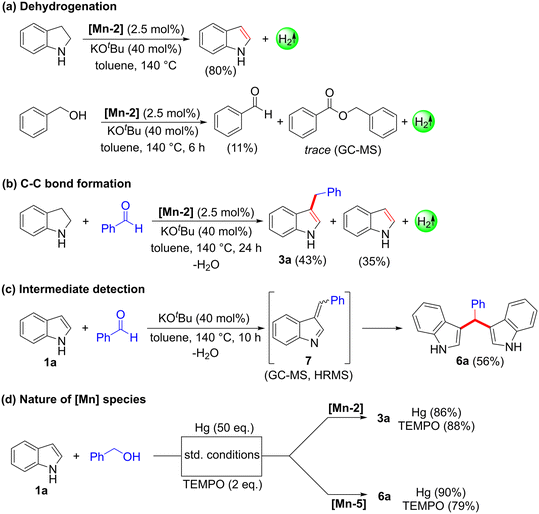 Open Access Article
Open Access ArticleCreative Commons Attribution 3.0 Unported Licence
Divergence in CH alkylation of indoles under Mn catalysis†
Akash
Mondal
 ,
Rohit
Kumar
,
Abhijith Karattil
Suresh
,
Manoj Kumar
Sahoo
and
Ekambaram
Balaraman
,
Rohit
Kumar
,
Abhijith Karattil
Suresh
,
Manoj Kumar
Sahoo
and
Ekambaram
Balaraman
 *
*
Department of Chemistry, Indian Institute of Science Education and Research (IISER) Tirupati, Tirupati – 517507, Andhra Pradesh, India. E-mail: eb.raman@iisertirupati.ac.in
First published on 24th August 2023
Abstract
Achieving divergence in CH alkylation of substrates using feedstock chemicals is an attractive paradigm to enable the production of diverse products from the same starting materials. Herein, we report manganese-catalyzed CH alkylation of indole/indolines with alcohols, where product selectivity is achieved through catalyst control. By use of a molecularly defined PNP–Mn(I) complex, tandem double dehydrogenative CH alkylation of indoles is observed. In contrast, an NNN–Mn(II)-based catalyst system provides a diverse range of value-added bis(indolyl)methanes (BIMs) via an interrupted borrowing hydrogen strategy. The present strategy was successfully applied for sustainable, scalable synthesis of several life science molecules (vibrindole A, turbomycin B alkaloid, and antileukemic and anticancer agents) and natural products (gramine, dipterine, etc.).
Introduction
Indole scaffolds are ubiquitous in the core structure of many natural and unnatural bioactive compounds, active pharmaceuticals, and agrochemicals and have prominent industrial applications.1 Various drugs like gramine, serotonin, tryptophan, corynantheine, oxypertine, bufotenine, and melatonin contain indole motifs.2 It is worth noting that ten of the top 200 best-selling small-molecule drugs of 2022 are indole derived with a global market share of nearly US$17.45 billion.3 Notably, several life science molecules contain C-alkylated indole units (Fig. 1). Thus, the widespread application of the indole moiety has attracted considerable attention to develop novel and sustainable catalytic methods for indole framework synthesis and selective modification.4 The method often applied to access C3-alkylated indoles is the Lewis acid-catalyzed Friedel–Crafts reaction using alkyl halides.5 However, the use of expensive and mutagenic haloalkanes makes the classical strategies unaffordable. Indeed, these strategies have inherent limitations, such as the generation of excessive toxic waste and poor regioselectivity.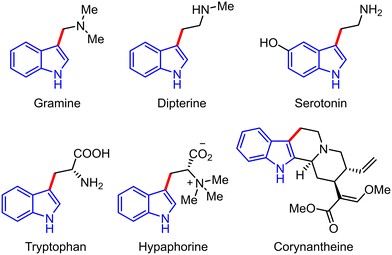 | ||
| Fig. 1 Natural products and pharmaceutical compounds containing 3-substituted indole motifs (selected examples). | ||
Recently, transition-metal-catalyzed acceptorless dehydrogenation and borrowing hydrogen (BH) strategies have emerged as powerful tools in chemical synthesis.6,7 These strategies are widely employed for C–C and C–N alkylation reactions.7 Indeed, this method uses alcohols as alkylating reagents as a benign and economical alternative to alkyl halides. Notably, the total number of available commercial alcohols is much higher than the number of alkyl halides.8 Likewise, C3 alkylation of indoles has been explored under borrowing hydrogen catalysis using precious transition metal catalysts such as Pd, Ir, and Ru.9 Recently, earth-abundant first-row transition metal complexes of Co, Mn, Fe, Cu, etc., with an elegant ligand backbone, have been used as an alternative to these expensive catalysts.10,11 Wang and co-workers12 reported an iridium-catalyzed hydrogen auto-transfer method for the C3 alkylation of indoles by directly employing indoline and alcohols as coupling partners. The research group of Kundu reported an Ir-catalyzed oxidative dehydrogenative coupling of indolines and alcohols to C3-alkylated indoles.13 A seminal work on manganese-catalyzed regioselective dehydrogenative C- versus N-alkylation enabled by a solvent switch was reported by Rueping and co-workers under Mn catalysis.14 Of late, Srimani and co-workers reported a manganese-catalyzed selective C3 functionalization of indoles and bis(indolyl)methane (BIM) derivative synthesis by tuning the reaction parameters.15
Equally, BIMs are essential molecules and play a vital role in organic synthesis and natural product chemistry. Several BIM derivatives exhibit pharmacological activities, including antimicrobial, antifungal, antibacterial, and anticancer.16 With this background, herein we develop an expedient, Mn-catalyzed strategy for the direct coupling of indolines with alcohols (aromatic, heterocyclic, and aliphatic alcohols) to access C3-alkylated indoles with the liberation of hydrogen gas. The present strategy involves double acceptorless dehydrogenation (indoline to indole and alcohols to aldehydes) and subsequent borrowing hydrogenation. This reaction is catalyzed by a single-site PNP–Mn(I) complex. Interestingly, under similar catalytic conditions, the NNN–Mn(II) system offered a diverse range of bis(indolyl)methanes.11e In the latter case, direct dehydrogenative coupling of indoles with alcohols followed by the IBH reaction is operative. Several drug molecules, such as gramine, dipterine, vibrindole A, and turbomycin B alkaloids, have been synthesized using our strategy under benign conditions. Such catalytic cascade dehydrogenative transformation of alcohols that enables divergence in CH alkylation of indoles under base metal catalysis is unprecedented (Scheme 1).
Results and discussion
The development of sustainable, earth-abundant, and non-precious transition-metal-based catalytic systems (Cu, Ni, Co, Fe, and Mn) is becoming more appealing for the replacement of noble rare-element-based catalytic chemical production.10,17 Such an attractive replacement contributes to preserving rare precious metal resources and brings new reactivity and selectivity patterns. In recent years, there has been growing evidence that molecular manganese complexes can be potential catalysts for (de)hydrogenation and related reactions.17,18Based on previous literature reports, we synthesized four different molecularly defined Mn(I)–PNP pincer complexes, i.e., Mn-1 to Mn-4, for our initial studies (Table 1).17a With the above complexes, we started screening C3 alkylation by considering indoline 1a and benzyl alcohol 2a as model substrates. To our delight, performing the reaction between 1a and 2a with a catalytic amount of Mn-1 complex and base resulted in a 67% isolated yield of the desired product 3a within 24 h. By increasing the time to 36 h, 84% yield of the product was obtained (Table 1, entries 1 and 2). Notably, the reaction requires a low catalyst loading, 2.5 mol% [Mn], and works efficiently with 40 mol% KOtBu. Lowering the reaction temperature from 140 °C (silicon oil bath temperature) decreases the yield of 3a to 53% (Table 1, entry 3). Screening other bases and their quantity, we observed that KOtBu is the most efficient base for the present Mn(I)–PNP-catalyzed tandem double acceptorless dehydrogenation/borrowing hydrogenation (Table 1, entries 4–7). A study on the solvent effect reveals that anhydrous toluene is the optimal solvent for this alkylation reaction (Table 1, entries 2 and 8–10; for more details on the effect of base and solvent, see the Experimental section in the ESI†). Interestingly, the catalyst [Mn-2] gave 88% yield, the highest isolated yield of 3a among all the manganese complexes screened under identical conditions, and was benchmarked as the optimal catalyst for further studies (Table 1, entries 2 and 11–13). Notably, the in situ generated complex also provided the same yield. A reduced base mol% loading resulted in lowering the yield of the desired product 3a (Table 1, entry 14). Under standard reaction conditions, the newly synthesized NNN–Mn complex Mn-5 (see the ESI†) did not yield product 3a.
| a Reaction conditions: 1a (0.60 mmol), 2a (0.90 mmol), cat.[Mn] (2.5 mol%), KOtBu (40 mol%), dry toluene (2 mL), 36 h in an open Ar atm. b Yield of the isolated product. c Yields of product 3a were determined by GC using m-xylene as an internal standard, nd = not detected. d GC conversion of indoline using m-xylene as an internal standard given in parenthesis. |
|---|
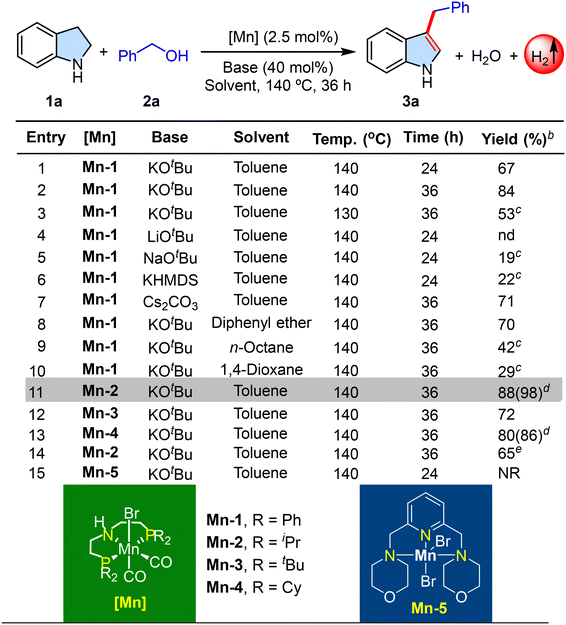
|
With these optimized reaction conditions in hand, we investigated the scope of indolines and alcohols to illustrate the versatility of the present Mn(I)–PNP-catalyzed CH alkylation of indolines with the liberation of hydrogen gas (Tables 2–4). Considering the model substrate 1a as a benchmark, a wide variety of alcohols, from benzyl alcohols to primary aliphatic alcohols, were subjected to the optimal conditions to evaluate their reactivity. From the study of the scope of alcohols, benzyl alcohol derivatives were found to be excellent candidates for this transformation. Benzyl alcohol, having a wide array of sensitive functional groups such as –F, –Cl, –Br, –SMe, –OCF3, –OPh, and –OBn at different positions of the aromatic ring, was well tolerated and smoothly proceeded to yield the desired products. The unsubstituted benzyl alcohol and its para-substituted derivatives with electron-donating groups gave the desired products (3a–3d and 3i–3j) in very good yields (64–88%). Also, meta-substituted benzyl alcohols with –Me, –OMe, –OPh, –OBn, and –NMe2 groups gave the corresponding desired products (3k, 3o–3r; up to 81% yield). The presence of an electron-deficient halogen atom or a –CF3 group at the para-position of the benzyl alcohol reduced the reactivity of the alcohol and yielded the desired products (3f–3h) in moderate to good yields (49–72%). Similarly, meta-substituted benzyl alcohols with –CF3 and –OCF3 groups gave the corresponding desired products (3m–3n) in moderate to good yields (59–69%). However, the –F attached C3-alkylated indoles 3e and 3l were obtained in poor yields of 36% and 42%, respectively. Methyl and methoxy groups at the ortho-position of the benzyl alcohol gave the corresponding products 3s and 3t in 70% and 63% isolated yields, respectively. This result indicated that the steric effect does not play a critical role in the initial dehydrogenation step. Moreover, the electronically biased 3,5-disubstituted benzyl alcohols underwent the reaction smoothly and gave the corresponding products 3u–3w in good to excellent yields (62–96%). The 3,5-bis-acetal substituted product 3x was obtained in a high isolated yield of 78%.
| a Reaction conditions: indoles (0.6 mmol, 1.0 equiv.), alcohols (0.9 mmol, 1.5 equiv.), cat.[Mn-2] (2.5 mol%), KOtBu (40 mol%), anhydrous toluene (2.0 mL), 140 °C (oil-bath temperature), 36 h, Ar atm. b Isolated yields. c Yield is based on an experiment conducted on a 5.0 mmol scale (5 mol% cat.[Mn-2]). |
|---|
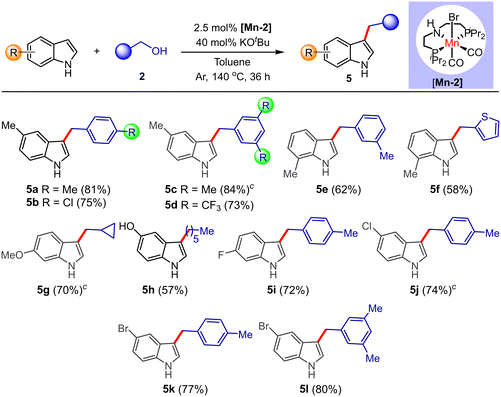
|
Favorably, 1-naphthylmethanol and 2-naphthylmethanol were subjected to catalytic conditions, and the corresponding C3-substituted indoles 3y and 3z were obtained in good yields (65% and 79%, respectively). Additionally, heteroaromatic furfuryl alcohol and 2-thiophene methanol underwent the C3 alkylation reaction and gave the corresponding products 3aa and 3ab in 52% and 46% isolated yields, respectively. Interestingly, when aliphatic alcohols were reacted with indoline under optimal conditions, the corresponding C3-alkylated indoles 3ac–3af were obtained in 49–64% isolated yields. Interestingly, we extended our strategy to obtain natural products gramine (3ag) and dipterine (3ah) with good yields in a one-step and one-pot manner. Gramine is an important antiviral and antibacterial agent, whereas dipterine is a less popular psychedelic drug. Also, we have synthesized an analogous dipterine-like molecule 3ai with a 50% isolated yield. Thus, the present PNP–Mn(I)-catalyzed CH alkylation strategy proceeding via tandem double acceptorless dehydrogenation/borrowing hydrogenation is general and shows a broad substrate scope with excellent functional group tolerance.
Next, keeping benzyl alcohol (2a) as the benchmark substrate, we have shown substrate scope with respect to indoline to demonstrate the generality of this reaction. Several electronically diverse indolines were employed under the present catalytic conditions, and we observed that the reaction proceeds smoothly and yields the desired C3-alkylated products in excellent yields. The methyl-group-substituted indolines gave the corresponding products 4a and 4b with 84% and 54% yields, respectively. The reduction of yield in the case of 4b may be attributed to the steric hindrance influence of the methyl group at the 7-position of the phenyl ring. Electron-donating methoxy-group-substituted indolines participated in the formation of 4c and 4d with 76% and 80% yields, respectively. 5-Benzyloxyindoline gives the product 4e with a 77% isolated yield. The aliphatic ring containing indoline yielded the desired product 4f with a 63% yield. The π-extended indoline produced the product 4g with a 51% yield. This is due to the steric influence of the 7th position of indoline. Strong electron-withdrawing fluoro-substituted indolines afforded the desired products 4h and 4i with 69% and 56% yields, respectively. The 5-chloro- and 5-bromo substituted indoline yielded the product 4j and 4k with 70% and 76% yields, respectively. Indeed, the 5,6-dichloro-substituted indoline provided the desired product 4l with a 66% isolated yield.
Notably, indole (instead of indoline) smoothly reacted with alcohols and yielded the CH-alkylated product in excellent yields. It was observed that both indoline and indole showed similar reactivity in the present Mn(I)–PNP catalysis. Thus, the initial dehydrogenation of indoline is not the rate-determining step. For the generality of the reaction, we have varied both the alcohol and the indole substrate scope. In most of the cases, we observed an excellent yield of the products. The methyl-substituted indole and benzyl alcohol derivatives yielded the products (5a–5d) in up to 84% yields. 7-Methylindole and 3-methylbenzyl alcohol, and 2-thiophenemethanol, gave the desired products 5e and 5f with 62% and 58% yields, respectively. Under our optimal conditions, cyclopropylmethanol and 6-methoxyindole gave the corresponding C3-alkylated indole 5g in 70% isolated yield. Interestingly, the reaction of 5-hydroxyindole with hexanol produced the expected product 5h with a 57% isolated yield. 6-Fluoroindole and 4-methylbenzyl alcohol gave the product 5i in 72% isolated yield. Other halo-substituted indoles with substituted benzyl alcohols produced the desired products (5j–5l) up to 80% yield.
A complete change in reactivity pattern was observed when the Mn(II)–NNN complex was employed for the dehydrogenative coupling of indole with alcohol. Thus, under similar reaction conditions, the Mn(II)–NNN complex produced bis(indole)methanes (BIMs) as a major product instead of the CH-alkylated product. This reaction proceeds via dehydrogenation followed by a Michael-type addition. Here, BIM is the sole product with the liberation of molecular hydrogen, and no formation of C3-alkylated indole was detected. This result indicates that the final (transfer)hydrogenation of the cyclic imine intermediate is slower than the Michael-type addition in the case of the Mn(II)–NNN catalytic system. Thus, Mn(II)–NNN follows an interrupted borrowing hydrogen (IBH) strategy.19 Notably, the in situ generated [Mn-5] complex did not yield the expected product in good yield (∼53% BIM). This result demonstrates the necessity and importance of molecularly defined complexes. This protocol has been successfully employed on a variety of indoles and alcohols (aromatic and aliphatic, including MeOH) to form a C–C bond through the IBH method (Table 5). Reasonably good substrate scope, functional group tolerance, and good-to-excellent yields are the highlights of the present protocol. To our delight, several life science molecules such as turbomycin B alkaloid (6a in 91% yield), vibrindole A (6f in 72% yield), molecules with an orphan nuclear receptor (6d in 60% yield) and antileukemic properties (6j in 85% yield), and ST-1385 (6g in 75% yield) were synthesized in excellent yields under our Mn(II)–NNN catalysis. Interestingly, under the present [Mn-5]-catalyzed conditions, an equimolar mixture of 6-bromoindole and 5-methoxyindole smoothly reacted with benzyl alcohol and yielded the unsymmetrical bis(indolyl)methane 6l in 54% isolated yield along with the formation of symmetrical products. Thus, it is concluded that the present tandem C–C bond formation proceeding via tandem dehydrogenation/interrupted borrowing hydrogen is general, selective, and compatible with a wide variety of substrates.
| a Reaction conditions: alcohol (0.5 mmol), indole (0.5 mmol), catalyst [Mn-5] (3 mol%), KOtBu (50 mol%), and toluene (2.0 mL) were heated at 130 °C (oil-bath temperature) for 24 h under Ar atm. b Isolated yields. c Yield is based on an experiment conducted on a 5.0 mmol scale (5 mol% cat.[Mn-5]). d The reaction was performed with alcohol (1 mL) under neat conditions, cat.[Mn-5] (10 mol%), and KOtBu (1.0 eq.) for 36 h under Ar atm. |
|---|
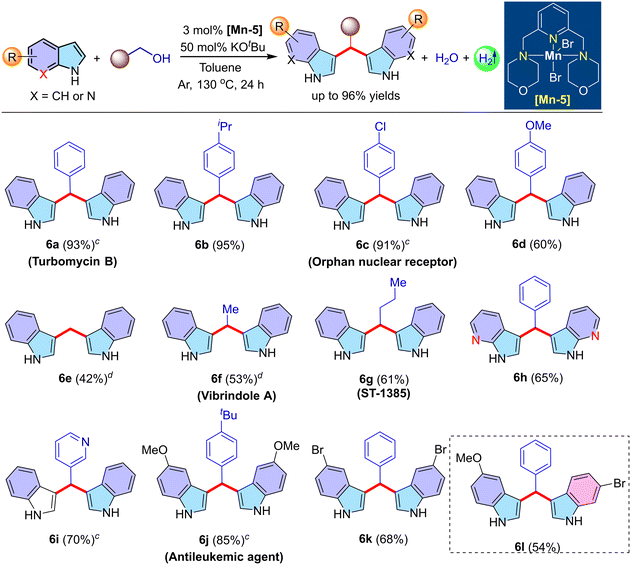
|
After establishing the reaction conditions, substrate scope, gram-scale synthesis (products 3i, 3q, 3u, 3ag, and 3ah in Table 2; products 4d and 4j in Table 3; products 5c, 5g and 5j in Table 4; products 6a, 6c, 6i and 6j in Table 5) applications in life science molecule synthesis, and generality of the present C–C bond forming reactions via tandem double dehydrogenation/BH and dehydrogenation/BH strategies, we were interested in mechanistic studies (Schemes 2 and 3 and Fig. 2). Thus, several control experiments were performed under standard reaction conditions. A deuterium labeling experiment of indoline and methanol-d4 afforded the desired product 3ac-d3 with 53% yield and 87% deuterium incorporation (Scheme 2a). Likewise, the reaction of indoline and ethanol-d6 produced the product 3ad-d5 with 60% yield and 91% deuterium incorporation. Deuterated benzyl alcohol 2a-d3 reacted with indoline and generated the product 3a-d2 with 77% yield and 67% deuterium incorporation (Scheme 2c). Less D incorporation in the product could be due to the H/D exchange with the in situ formed H2O. These results confirm that the reaction proceeds via the borrowing hydrogen path. Qualitative gas analysis using an OmniStar™ gas analyzer shows the formation of D2, HD, and H2 (see the ESI†). We failed to quantify the hydrogen gas in the ADC coupling reaction. We believe that the active metal-hydride species may be stable only under hydrogenation conditions.
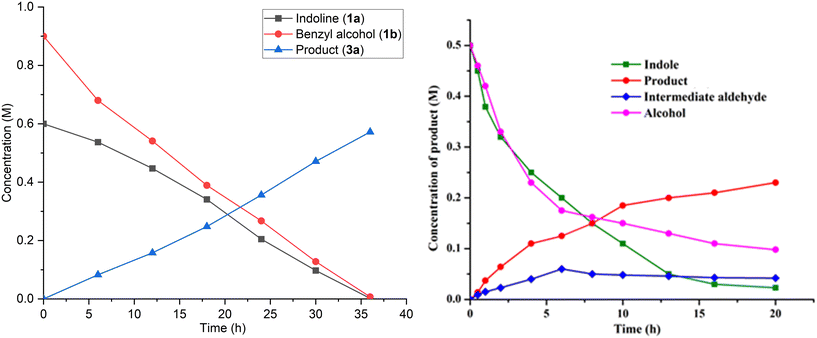 | ||
| Fig. 2 Kinetic profiles of (left) [Mn-2]-catalyzed double AD/BH reaction of indoline (1a) and benzyl alcohol (2a) and (right) [Mn-5]-catalyzed AD/IBH reaction of indole and benzyl alcohol (2a). | ||
Control experiments show that a single-site manganese catalyst, i.e. Mn(I)–PNP complex [Mn-2], dehydrogenates both indoline and benzyl alcohol to indole and benzaldehyde under acceptorless conditions, respectively. We observed 85% conversion of indoline and 80% yield of indole by GC analysis under optimal conditions (Scheme 3a). Under standard reaction conditions (in the absence of 1a), after a short reaction time of 6 h, benzyl alcohol is converted to benzaldehyde (11%) and a trace amount of benzyl benzoate under catalytic conditions (Scheme 3b). An independent reaction of indoline and benzaldehyde afforded the desired product (3a) in a 43% isolated yield under Mn(I)–PNP catalysis. Indeed, the intermediate aldehyde was completely consumed, and other competing base-mediated reactions were also observed (Scheme 3c). This result indicates that in situ (slow) formation of the alcohol dehydrogenated product, i.e., aldehyde, is very important to achieve the maximum yield of the CH-alkylated product. A simple base-mediated condensation between indole and benzaldehyde gives an imine intermediate (7). Compound 7 was detected by GC as well as GC-MS analysis. We believe that intermediate 7 undergoes selective 1,4-hydrogenation to give the CH-alkylated product (3a) under Mn(I)–PNP catalysis. In contrast, in the presence of cat.[Mn-5] the final (transfer)hydrogenation of the alkylideneindolenine (7) intermediate is slower than the Michael-type addition, and on further reaction with another indole moiety to provide the bis(indole)methane (BIM) as the sole product with the liberation of molecular hydrogen no formation of C3-alkylated indole was detected. The results show that the catalyst influences the CH alkylation of indoles under Mn catalysis. PNP–Mn(I) is very efficient for the borrowing hydrogenation (BH) reaction, while NNN–Mn(II) [Mn-5] has lower activity, and interrupted borrowing hydrogenation (IBH) reaction takes place. The liberation of hydrogen gas during the Mn(II)–NNN catalysis was qualitatively analyzed by GC. Thus, it can be concluded that both Mn(I)–PNN and Mn(II)–NNN catalytic systems behave antagonistically and follow BH and IBH strategies, respectively. Next, a reaction in the presence of 50 equiv. of mercury (Hg) did not affect the reaction, and we observed an 86% yield of the product. This result implies the homogeneous nature of the present catalytic systems. A similar reaction was performed with two equivalents of radical scavengers (2,2,6,6-tetramethylpiperidin-1-yl)oxyl (TEMPO), and this experiment also shows that the reaction did not proceed through a single-electron path (Scheme 3d). It is worth mentioning that Marques and coworkers20 proposed a radial coupling mechanism for the formation of BIM using a stoichiometric amount of KtOBu under mediated conditions. To clarify if metal-mediated dehydrogenation is involved or not, we conducted kinetic studies on the reaction using different concentrations of NNN–Mn(II) [Mn-5]. The experimental results demonstrate that these one-pot tandem reactions are purely homogeneous, and the scope of the free radical mechanism can also be ruled out completely.
Finally, we performed kinetic experiments for both the catalytic systems. Accordingly, we monitored the reaction progress at a time interval of 6 hours and determined the concentration of substrate benzyl alcohol and indoline and the product by GC analysis. With the results, we have drawn a concentration vs. time plot, and the kinetic profile shows that this reaction depends on indoline/indole and benzyl alcohol concentration.
Based on several intermediate isolation control and labeling experiments, we have drawn a plausible catalytic cycle for the present Mn-catalyzed tandem AD/BH and AD/IBH strategies for CH alkylation of indoline (in the presence of [Mn-2]) or indole (Scheme 4). For better understanding, we have split the catalytic cycle into two sub-cycles, namely, cycle 1 and cycle 2. Cycle 1 represents alcohol dehydrogenation, while cycle 2 represents indoline dehydrogenation. Catalytically active Mn(I) complex is formed upon treatment of Mn-2 with a base (KOtBu). The first step of cycle 1 is the O–H bond activation of alcohol by Mn(I) to form manganese alkoxy intermediate III. This intermediate closely holds the β-proton of the alkoxide group through β-agostic interaction. Finally, β-hydride elimination eliminates aldehyde and generates manganese hydride complex Mn(I)H2. In cycle 2, the N–H bond activation of indoline by the Mn(I) complex generates imido manganese intermediate I. This intermediate exhibits an intramolecular β-agostic interaction,21 and we mostly believe intermediate II will be generated. Intermediate II undergoes β-hydride elimination to generate a cyclic imine type intermediate (IM-1)22 and manganese hydride Mn(I)H2 complex. Indeed, the active Mn(I) complex and Mn(I)H2 complex will be in equilibrium. The cyclic imine intermediate (7) undergoes aromaticity-driven tautomerization at a relatively high temperature to produce indole.23 Subsequently, a base-mediated condensation reaction of indole with an aldehyde formed a 1,3-unsaturated intermediate (7). Finally, this alkylideneindolenine intermediate is selectively 1,4-hydrogenated with the aid of Mn(I)H2 to give the desired product, C3-alkylated indole. In contrast, in the case of Mn(II)–NNN catalysis (i.e. cat.[Mn-5]), the final (transfer)hydrogenation of the alkylideneindolenine (7) intermediate is slower than the Michael-type nucleophilic addition, and hence, further reaction with another indole moiety is required to provide the BIMs. Notably, the condensation of indole with benzaldehyde under Mn(IIII)-–NNN catalysis was found to be fast, and a similar rate was observed when the reaction was performed with only KOtBu (see the ESI†). This result suggests that the Mn(II)–NNN catalyst is playing a key role in the initial dehydrogenation of alcohol to give the corresponding aldehyde, while KOtBu catalyzes the condensation of indole with in situ formed aldehyde, giving intermediate 7, and finally yields the BIMs.
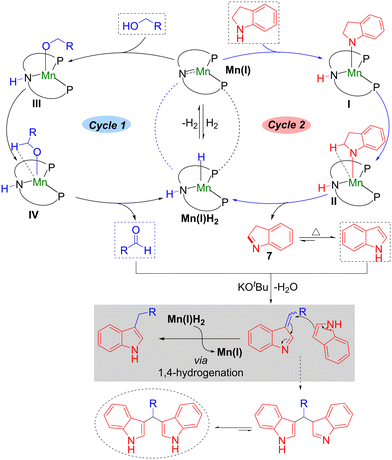 | ||
| Scheme 4 A plausible mechanism for Mn(I)-catalyzed double dehydrogenative coupling of indolines with alcohols. | ||
Conclusions
In conclusion, we disclose judiciously chosen molecularly defined manganese complexes for the catalytic CH alkylation of indole/indolines with alcohols. The basic features of the present reaction are generality, selectivity, and wide substrate scope. A chemodivergence in the present CH alkylation is achieved through catalyst control. By use of a single-site PNP–Mn(I) complex, tandem double dehydrogenative CH alkylation of indoles is observed. Antagonistically, an NNN–Mn(II)-based catalyst system provides a diverse range of bis(indolyl)methanes (BIMs) via interrupted borrowing hydrogen. The present Mn catalysis was successfully applied for the sustainable, scalable, and benign synthesis of several life science molecules (vibrindole A, turbomycin B alkaloid, and antileukemic and anticancer agents) and natural products (gramine, dipterine, etc.).Author contributions
AM and EB conceived and designed the project. AM performed the optimization studies, substrate scope, and mechanistic studies. RK and AKS helped in the substrate scope and mechanistic studies. AM, MKS and EB wrote the manuscript. All authors have given approval to the final version of the manuscript.Conflicts of interest
The authors declare no competing financial interest.Acknowledgements
This work is supported by CSIR (Project No.: 01/(3030)/21/EMR-II). E. B. acknowledges funding from a Swarnajayanti Fellowship (SERB/F/5892/2020-2021) and gratefully acknowledges support from the Alexander-von-Humboldt (AvH) Foundation. A. K. S. acknowledges UGC, India and R. K. thanks IISER-Tirupati for the fellowships. We thank IISER-Tirupati for providing excellent analytical facilities.Notes and references
- (a) E. Mahmoud, A. M. Hayallah, S. Kovacic, D. Abdelhamid and M. Abdel-Aziz, Pharmacol. Rep., 2022, 74, 570–582 CrossRef CAS PubMed; (b) A. Dorababu, RSC Med. Chem., 2020, 11, 1335–1353 RSC; (c) Y. C. Wan, Y. H. Li, C. X. Yan, M. Yan and Z. L. Tang, Eur. J. Med. Chem., 2019, 183, 111691 CrossRef CAS PubMed; (d) T. P. Singh and O. M. Singh, Mini-Rev. Med. Chem., 2018, 18, 9–25 CrossRef CAS PubMed; (e) T. V. Sravanthi and S. L. Manju, Eur. J. Pharm. Sci., 2016, 91, 1–10 CrossRef CAS PubMed.
- (a) A. Mehra, V. Sharma, A. Verma, S. Venugopal, A. Mittal, G. Singh and B. Kaur, ChemistrySelect, 2022, 7, e202202361 CrossRef CAS; (b) Y. Cao, C. Luo, P. Yang, P. Li and C. Wu, Med. Chem. Res., 2021, 30, 501–518 CrossRef CAS; (c) J. S. S. Neto and G. Zeni, Org. Chem. Front., 2020, 7, 155–210 RSC; (d) M.-Z. Zhang, Q. Chen and G.-F. Yang, Eur. J. Med. Chem., 2015, 89, 421–441 CrossRef CAS PubMed.
- (a) L. Urquhart, Nat. Rev. Drug Discovery, 2022, 22, 260 CrossRef PubMed; (b) Indole Market Size, Capacity, Demand & Supply 2023: https://www.24chemicalresearch.com/reports/207706/global-indole-forecast-market-2023-2029-571.
- (a) M. Bandini and A. Eichholzer, Angew. Chem., Int. Ed., 2009, 48, 9608–9644 CrossRef CAS PubMed; (b) M. Shiri, Chem. Rev., 2012, 112, 3508–3539 CrossRef CAS PubMed; (c) J. A. Leitch, Y. Bhonoah and C. G. Frost, ACS Catal., 2017, 7, 5618–5627 CrossRef CAS; (d) J. Chen and J. Wu, Angew. Chem., Int. Ed., 2017, 56, 3951–3955 CrossRef CAS PubMed; (e) Y.-C. Hu, D.-W. Ji, C.-Y. Zhao, H. Zheng and Q.-A. Chen, Angew. Chem., Int. Ed., 2019, 58, 5438–5442 CrossRef CAS PubMed; (f) D. Mondal, P. Kalar, S. Kori, S. Gayen and K. Das, Curr. Org. Chem., 2020, 24, 2665–2693 CrossRef CAS; (g) K. Urbina, D. Tresp, K. Sipps and M. Szostak, Adv. Synth. Catal., 2021, 363, 2723–2739 CrossRef CAS.
- (a) M. Bandini and A. Umani-Ronchi, in Catalytic Asymmetric Friedel-Crafts Alkylations, Wiley-VCH, Weinheim, 2009, vol. 351, pp. 2521–2524 CrossRef; (b) M. Rueping and B. J. Nachtsheim, Beilstein J. Org. Chem., 2010, 6, 6 CrossRef PubMed; (c) D. F. Taber and P. K. Tirunahari, Tetrahedron, 2011, 67, 7195–7210 CrossRef CAS PubMed.
- For selected review on ADC strategy, see: (a) J. Choi, A. H. R. MacArthur, M. Brookhart and A. S. Goldman, Chem. Rev., 2011, 111, 1761–1779 CrossRef CAS PubMed; (b) F. Huang, Z. Liu and Z. Yu, Angew. Chem., Int. Ed., 2016, 55, 862–875 CrossRef CAS PubMed; (c) C. Gunanathan and D. Milstein, Science, 2013, 341, 1229712 CrossRef PubMed; (d) Q. Yang, Q. Wang and Z. Yu, Chem. Soc. Rev., 2015, 44, 2305–2329 RSC; (e) R. H. Crabtree, Chem. Rev., 2017, 117, 9228–9246 CrossRef CAS PubMed; (f) A. Kumar, P. Daw and D. Milstein, Chem. Rev., 2022, 122, 385–441 CrossRef CAS PubMed.
- For selected review on BH strategy, see: (a) S. Bähn, S. Imm, L. Neubert, M. Zhang, H. Neumann and M. Beller, ChemCatChem, 2011, 3, 1853–1864 CrossRef; (b) G. Guillena, D. J. Ramón and M. Yus, Chem. Rev., 2010, 110, 1611–1641 CrossRef CAS PubMed; (c) A. Corma, J. Navas and M. J. Sabater, Chem. Rev., 2018, 118, 1410–1459 CrossRef CAS PubMed; (d) B. G. Reed-Berendt, K. Polidano and L. C. Morrill, Org. Biomol. Chem., 2019, 17, 1595–1607 RSC; (e) B. G. Reed-Berendt, D. E. Latham, M. B. Dambatta and L. C. Morrill, ACS Cent. Sci., 2021, 7, 570–585 CrossRef CAS PubMed; (f) E. Podyacheva, O. I. Afanasyev, D. V. Vasilyev and D. Chusov, ACS Catal., 2022, 12, 7142–7198 CrossRef CAS; (g) P. Chandra, S. Chakroborty and K. Pal, Top. Catal., 2022, 65, 1821–1859 CrossRef CAS.
- T. Suga, Y. Takahashi, C. Miki and Y. Ukaji, Angew. Chem., 2022, 61, e202112533 CrossRef CAS PubMed.
- (a) S. Whitney, R. Grigg, A. Derrick and A. Keep, Org. Lett., 2007, 9, 3299–3302 CrossRef CAS PubMed; (b) S. Imm, S. Bahn, A. Tillack, K. Mevius, L. Neubert and M. Beller, Chem. – Eur. J., 2010, 16, 2705–2709 CrossRef CAS PubMed; (c) C. M. Wong, K. Q. Vuong, M. R. D. Gatus, C. Hua, M. Bhadbhade and B. A. Messerle, Organometallics, 2012, 31, 7500–7510 CrossRef CAS; (d) C. Sun, X. Zou and F. Li, Chem. – Eur. J., 2013, 19, 14030–14033 CrossRef CAS PubMed; (e) S. M. A. H. Siddiki, K. Kon and K.-I. Shimizu, Green Chem., 2015, 17, 173–177 RSC; (f) S. Bartolucci, M. Mari, A. Bedini, G. Piersanti and G. Spadoni, J. Org. Chem., 2015, 80, 3217–3222 CrossRef CAS PubMed; (g) S.-J. Chen, G.-P. Lu and C. Cai, RSC Adv., 2015, 5, 70329–70332 RSC; (h) X. Jiang, W. Tang, D. Xue, J. Xiao and C. Wang, ACS Catal., 2017, 7, 1831–1835 CrossRef CAS; (i) N. Biswas, R. Sharma and D. Srimani, Adv. Synth. Catal., 2020, 362, 2902–2910 CrossRef CAS.
- (a) R. M. Bullock, Catalysis without Precious Metals, Wiley, 2011 Search PubMed; (b) R. M. Bullock, Science, 2013, 342, 1054–1056 CrossRef CAS PubMed; (c) T. Zell and D. Milstein, Acc. Chem. Res., 2015, 48, 1979–1994 CrossRef CAS PubMed; (d) P. Chirik and R. Morris, Acc. Chem. Res., 2015, 48, 2495 CrossRef CAS PubMed; (e) S. Chakraborty, P. Bhattacharya, H. Dai and H. Guan, Acc. Chem. Res., 2015, 48, 1995–2003 CrossRef CAS PubMed; (f) X. Du and Z. Huang, ACS Catal., 2017, 7, 1227–1243 CrossRef CAS; (g) T. Zell and R. Langer, ChemCatChem, 2018, 10, 1930–1940 CrossRef CAS; (h) F. Kallmeier and R. Kempe, Angew. Chem., Int. Ed., 2018, 57, 46–60 CrossRef CAS PubMed; (i) Y. Cai, F. Li, Y. Q. Li, W. B. Zhang, F. H. Liu and S. L. Shi, Tetrahedron Lett., 2018, 59, 1073–1079 CrossRef CAS; (j) A. Mukherjee and D. Milstein, ACS Catal., 2018, 8, 11435–11469 CrossRef CAS; (k) W. Liu, B. Sahoo, K. Junge and M. Beller, Acc. Chem. Res., 2018, 51, 1858–1869 CrossRef CAS PubMed; (l) B. G. Reed-Berendt, K. Polidano and L. C. Morrill, Org. Biomol. Chem., 2019, 17, 1595–1607 RSC; (m) T. Irrgang and R. Kempe, Chem. Rev., 2019, 119, 2524–2549 CrossRef CAS PubMed; (n) W. Ai, R. Zhong, X. Liu and Q. Liu, Chem. Rev., 2019, 119, 2876–2953 CrossRef CAS PubMed; (o) K. Junge, V. Papa and M. Beller, Chem. – Eur. J., 2019, 25, 122–143 CrossRef CAS PubMed; (p) L. Alig, M. Fritz and S. Schneider, Chem. Rev., 2019, 119, 2681–2751 CrossRef CAS PubMed; (q) R. M. Bullock, J. G. Chen, L. Gagliardi, P. J. Chirik, O. K. Farha, C. H. Hendon, C. W. Jones, J. A. Keith, J. Klosin, S. D. Minteer, R. H. Morris, A. T. Radosevich, T. B. Rauchfuss, N. A. Strotman, A. Vojvodic, T. R. Ward, J. Y. Yang and Y. Surendranath, Science, 2020, 369, eabc3183 CrossRef CAS PubMed; (r) J. Wen, F. Wang and X. Zhang, Chem. Soc. Rev., 2021, 50, 3211–3237 RSC.
- (a) G. Di Gregorio, M. Mari, F. Bartoccini and G. Piersanti, J. Org. Chem., 2017, 82, 8769–8775 CrossRef CAS PubMed; (b) C. Seck, M. D. Mbaye, S. Gaillard and J.-L. Renaud, Adv. Synth. Catal., 2018, 360, 4640–4645 CrossRef CAS; (c) N.-K. Nguyen, D. H. Nam, B. V. Phuc, V. H. Nguyen, Q. T. Trinh, T. Q. Hung and T. T. Dang, Mol. Catal., 2021, 505, 111462 CrossRef CAS; (d) M. Hu, Y. Jiang, N. Sun, B. Hu, Z. Shen, X. Hu and L. Jin, New J. Chem., 2021, 45, 10057–10062 RSC; (e) S. Basak, A. Alvarez-Montoya, L. Winfrey, R. L. Melen, L. C. Morrill and A. P. Pulis, ACS Catal., 2020, 10, 4835–4840 CrossRef CAS PubMed; (f) V. Yadav, E. Balaraman and S. B. Mhaske, Adv. Synth. Catal., 2021, 363, 4430–4439 CrossRef CAS; (g) A. K. Bains, A. Biswas and D. Adhikari, Chem. Commun., 2020, 56, 15442–15445 RSC; (h) V. Arun, L. Roy and S. De Sarkar, Chem. – Eur. J., 2020, 26, 16649–16654 CrossRef CAS PubMed; (i) M. Zhao, X. Li, X. Zhang and Z. Shao, Asian J. Chem., 2022, 17, e202200483 CrossRef CAS PubMed; (j) Kamal, M. Khatua, S. Rani, B. Goswami and S. Samanta, J. Org. Chem., 2023, 88, 5827–5843 CrossRef CAS PubMed; (k) B. Zhou, Z. Ma, A. M. Alenad, C. Kreyenschulte, S. Bartling, M. Beller and R. V. Jagadeesh, Green Chem., 2022, 24, 4566–4572 RSC.
- X. Jiang, W. Tang, D. Xue, J. Xiao and C. Wang, ACS Catal., 2017, 7, 1831–1835 CrossRef CAS.
- M. Maji, I. Borthakur, S. Srivastava and S. Kundu, J. Org. Chem., 2022, 87, 5603–5616 CrossRef CAS PubMed.
- J. C. Borghs, V. Zubar, L. M. Azofra, J. Sklyaruk and M. Rueping, Org. Lett., 2020, 22, 4222–4227 CrossRef CAS PubMed.
- A. Mondal, R. Sharma, B. Dutta, D. Pal and D. Srimani, J. Org. Chem., 2022, 87, 3989–4000 CrossRef CAS PubMed.
- (a) M. Shiri, M. A. Zolfigol, H. G. Kruger and Z. Tanbakouchian, Chem. Rev., 2010, 110, 2250–2293 CrossRef CAS PubMed; (b) T. Yang, H. Lu, Y. Shu, Y. Ou, L. Hong, C. T. Au and R. Qiu, Org. Lett., 2020, 22, 827–831 CrossRef CAS PubMed; (c) X.-X. Sun, B.-X. Du, H.-H. Zhang, L. Ji and F. Shi, ChemCatChem, 2015, 7, 1211–1221 CrossRef CAS.
- For selected recent examples of Mn-catalyzed BH reactions, see: (a) S. Elangovan, J. Neumann, J. B. Sortais, K. Junge, C. Darcel and M. Beller, Nat. Commun., 2016, 7, 12641–12649 CrossRef PubMed; (b) B. Maji and M. Barman, Synthesis, 2017, 49, 3377–3393 CrossRef CAS; (c) N. Gorgas and K. Kirchner, Acc. Chem. Res., 2018, 51, 1558–1569 CrossRef CAS PubMed; (d) M. Garbe, K. Junge and M. Beller, Eur. J. Org. Chem., 2017, 30, 4344–4362 CrossRef; (e) S. Waiba and B. Maji, ChemCatChem, 2020, 12, 1891–1902 CrossRef CAS; (f) Y. Wang, M. Wang, Y. Li and Q. Liu, Chem, 2021, 7, 1180–1223 CrossRef CAS; (g) K. Das, S. Waiba, A. Janaa and B. Maji, Chem. Soc. Rev., 2022, 51, 4386–4464 RSC.
- Selected examples on pincer ligand-based manganese-catalyzed AD/BH reactions, see: (a) A. Mukherjee, A. Nerush, G. Leitus, L. J. W. Shimon, Y. Ben David, N. A. Espinosa Jalapa and D. Milstein, J. Am. Chem. Soc., 2016, 138, 4298–4301 CrossRef CAS PubMed; (b) S. Elangovan, C. Topf, S. Fischer, H. Jiao, A. Spannenberg, W. Baumann, R. Ludwig, K. Junge and M. Beller, J. Am. Chem. Soc., 2016, 138, 8809–8814 CrossRef CAS PubMed; (c) F. Kallmeier, T. Irrgang, T. Dietel and R. Kempe, Angew. Chem., Int. Ed., 2016, 55, 11806–11809 CrossRef CAS PubMed; (d) M. Mastalir, M. Glatz, E. Pittenauer, G. Allmaier and K. Kirchner, J. Am. Chem. Soc., 2016, 138, 15543–15546 CrossRef CAS PubMed; (e) S. Fu, Z. Shao, Y. Wang and Q. Liu, J. Am. Chem. Soc., 2017, 139, 11941–11948 CrossRef CAS PubMed; (f) N. V. Kulkarni, W. W. Brennessel and W. D. Jones, ACS Catal., 2018, 8, 997–1002 CrossRef CAS; (g) P. Ryabchuk, K. Stier, K. Junge, M. P. Checinski and M. Beller, J. Am. Chem. Soc., 2019, 141, 16923–16929 CrossRef CAS PubMed; (h) J. Sklyaruk, J. C. Borghs, O. El-Sepelgy and M. Rueping, Angew. Chem., Int. Ed., 2019, 58, 775–779 CrossRef CAS PubMed; (i) S. S. Gawali, B. K. Pandia and C. Gunanathan, Org. Lett., 2019, 21, 3842–3847 CrossRef CAS PubMed; (j) L. Zhang, Z. Wang, Z. Han and K. Ding, Angew. Chem., 2020, 59, 15565–15569 CrossRef CAS PubMed; (k) X. Liu and T. Werner, Chem. Sci., 2021, 12, 10590–10597 RSC; (l) A. Mondal, R. Sharma, D. Pal and D. Srimani, Chem. Commun., 2021, 57, 10363–10366 RSC; (m) J. M. Pérez, R. Postolache, M. CastiñeiraReis, E. G. Sinnema, D. Vargová, F. de Vries, E. Otten, L. Ge and S. R. Harutyunyan, J. Am. Chem. Soc., 2021, 143, 20071–20076 CrossRef PubMed; (n) C.-Q. Deng, J. Deng and Y. Fu, Green Chem., 2022, 24, 8477–8483 RSC; (o) A. E. Owen, A. Preiss, A. McLuskie, C. Gao, G. Peters, M. Bühl and A. Kumar, ACS Catal., 2022, 12, 6923–6933 CrossRef CAS; (p) S. Waiba, M. Maiti and B. Maji, ACS Catal., 2022, 12, 3995–4001 CrossRef CAS; (q) G. Sivakumar, M. Subaramanian and E. Balaraman, ACS Sustainable Chem. Eng., 2022, 10, 7362–7373 CrossRef CAS; (r) A. Mondal, A. K. Suresh, G. Sivakumar and E. Balaraman, Org. Lett., 2022, 24, 8990–8995 CrossRef CAS PubMed; (s) C. L. Oates, A. S. Goodfellow, M. Bühl and M. L. Clarke, Angew. Chem., 2023, 62, e202212479 CrossRef CAS PubMed; (t) R. Babu, S. S. Padhy, G. Sivakumar and E. Balaraman, Catal. Sci. Technol., 2023, 13, 2763–2771 RSC; (u) F. Sun, J. Huang, Z. Wei, C. Tang and W. Liu, Angew. Chem., Int. Ed., 2023, e202303433 CAS.
- M. Nallagangula, M. Subaramanian, R. Kumar and E. Balaraman, Chem. Commun., 2023, 59, 7911 RSC.
- A. S. Santos, R. D. Ferro, N. Viduedo, L. B. Maia, A. M. S. Silva and M. M. B. Marques, Chemistryopen, 2023, 12, e202200265 CrossRef CAS PubMed.
- M. Brookhart, M. L. H. Green and G. Parkin, Proc. Natl. Acad. Sci. U. S. A., 2007, 104, 6908–6914 CrossRef CAS PubMed.
- (a) J. M. Stubbs, R. J. Hazlehurst, P. D. Boyle and J. M. Blacquiere, Organometallics, 2017, 36, 1692–1698 CrossRef CAS; (b) P. T. K. Arachchige, H. Lee and C. S. Yi, J. Org. Chem., 2018, 83, 4932–4947 CrossRef CAS PubMed.
- F. Dubnikova and A. Lifshitz, J. Phys. Chem. A, 2001, 105, 36053614 CrossRef.
Footnote |
| † Electronic supplementary information (ESI) available: General information, experimental details, control experiments, kinetic studies, synthesis and characterization of products, copies of 1H and 13C NMR, and X-ray data of [Mn-5]. See DOI: https://doi.org/10.1039/d3cy01044a |
| This journal is © The Royal Society of Chemistry 2023 |

